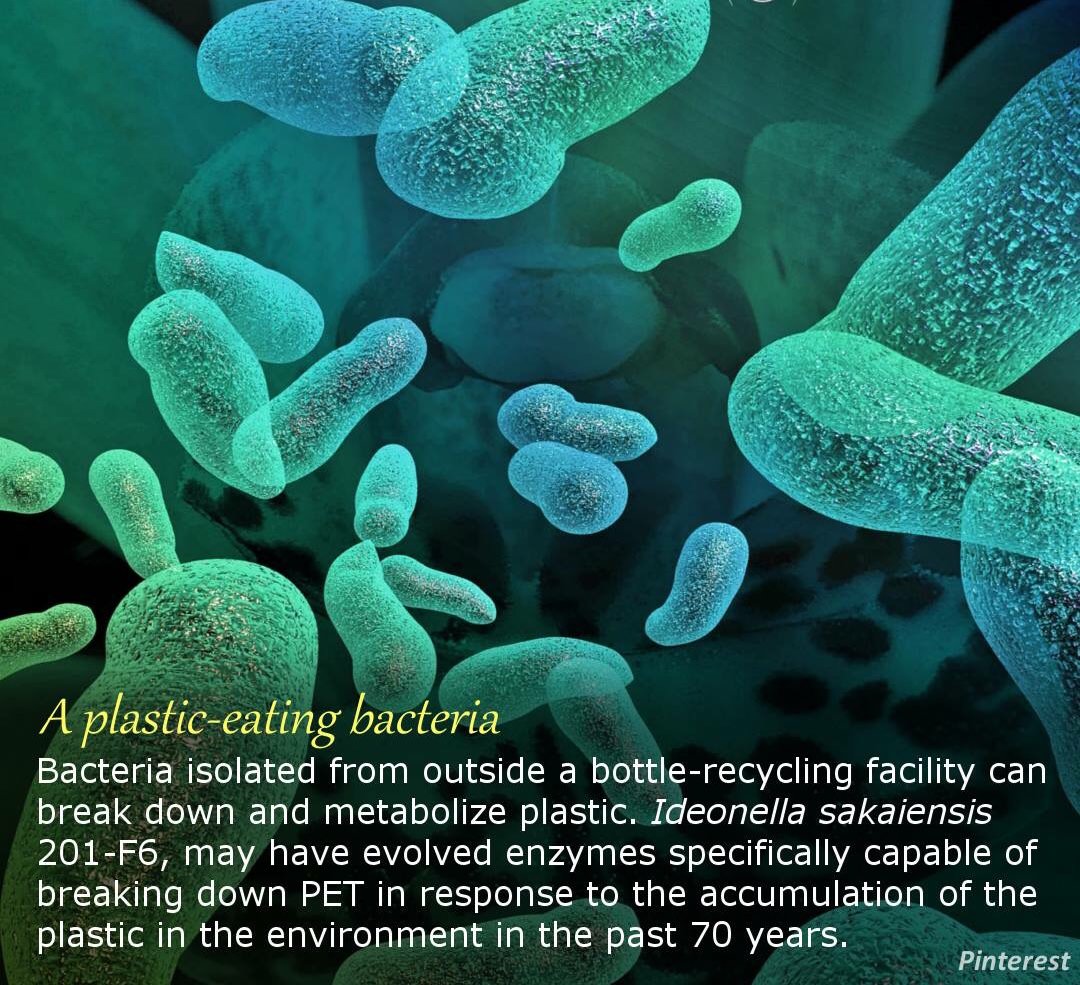Plastic-Eating Enzymes
Key concepts:
• PET (used to make plastic bottles) takes hundreds of years to degrade
• French team with a PET-consuming enzyme
• UK team with a PET-consuming enzyme
• examples of bio-mimicry inspired by mealworms and waxworms
The Goal: If PET could be recycled, rather than using fossil fuels to create new plastic, this would not only reduce plastic pollution but also address climate change. PET takes hundreds of years to degrade in the environment. A French team and a UK team are both racing to discover a super enzyme that can consume and break down the plastic PET (polyethylene terephthalate) in plastic bottles.
In 2021, Carbios, a French company, will test its PET-eating enzyme at a demonstration plant near the city of Lyon, described in “An engineered PET depolymerase to break down and recycle plastic bottles” on April 8, 2020 in Nature. On May 21, 2020 Nature Biotechnology covered this breakthrough as Closing the recycling circle: capturing the value back from plastic waste has been the holy grail of recyclers. Biotechnology is taking us closer to a solution.

The 2018 discovery was a lucky accident scientists examined more closely the crystal structure of a recently discovered enzyme called PETase, which evolved naturally and was already known to break down and digest plastic made of polyethylene terephthalate (PET). When they introduced a mutation to PETase, they produced a new type of enzyme that can digest plastic more efficiently than the enzyme discovered in 2016.
The 2018 discovery was a mutant enzyme that was even more efficient at breaking down plastic waste, signaling new progress in the international quest for ways to reduce plastic waste. These scientists from the University of Portsmouth in the UK and the US Department of Energy’s National Renewable Energy Laboratory in the US claim to have engineered an enzyme that eats plastic, specifically that can digest polyethylene terephthalate, or PET, and this next step is also reported in the Smithsonian.
See the app @ earthDECKS.org
Saving Our Oceans from Plastic: articles by Zann Gill
- Adverse Health Effects of Plastic
- Aquaria – Informal Learning Network
- Beat the Microbead
- Bibliography: Plastic Roads
- Boyan Slat: Floater Technology for Ocean Cleanup
- Complex Systems Problems
- Cradle to Grave: Plastic Supply Chain
- Dame Ellen MacArthur: The Circular Economy
- Sylvia Earle: Learning for a Plastic World
- earthDECKS Limelights: Companies to Watch
- Enshrouded in Plastic
- Flamingos Signal the Future We Face
- Floating Trash: More than 4x as bad as we thought
- Give the World a Helping Hand: 3D Prostheses
- Global Ocean Sensing
- Industry Response to the Plastic Challenge
- Nature’s Innovators: plastic consumers
- Ocean Debris Network
- Ocean Ingenuity
- Oceans – Measuring Planet Health
- Plastic Bank – The Exchange Economy
- Plastic – Climate Change Connection: Israel & UBQ
- PLASTIC: Complex Systems Problem
- Plastic: Drinking Water, Table Salt & Mother’s Milk
- Plastic Footprint ~ Carbon Footprint
- Plastic Gyres and Social Justice
- Plastic Impact Calculator
- Plastic Pollution Coalition: Campaign vs Single Use Plastic
- Plastic & Public Health: Endocrine Disruptors
- PLASTIC: Overview of National Leadership
- Plastic Roads – Global Innovation Ecosystem
- Plastic Strategies for Innovation
- The Plasticene
- Plastiki: adventure stories & a big message
- Raising Awareness of Plastic Hazards
